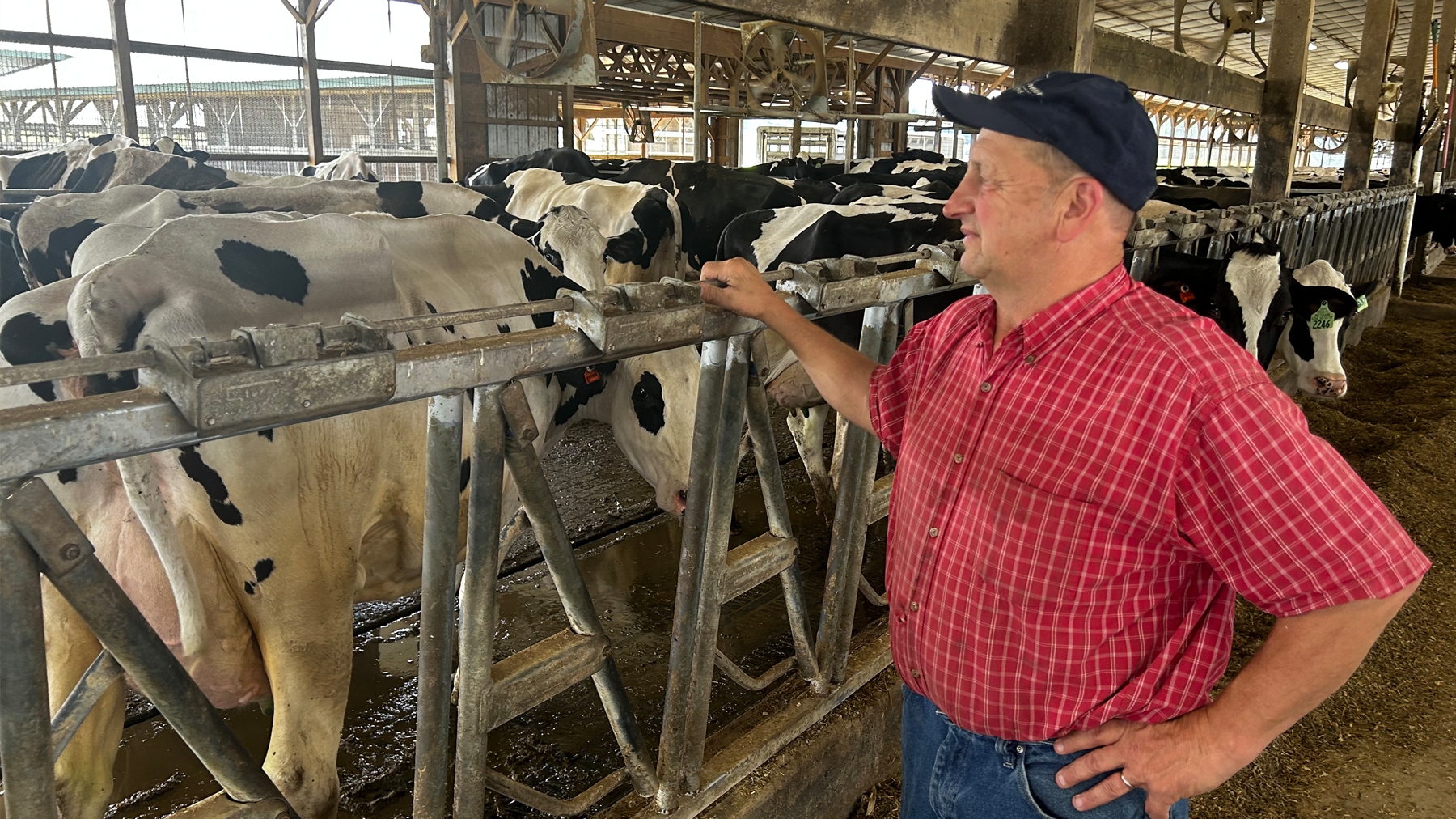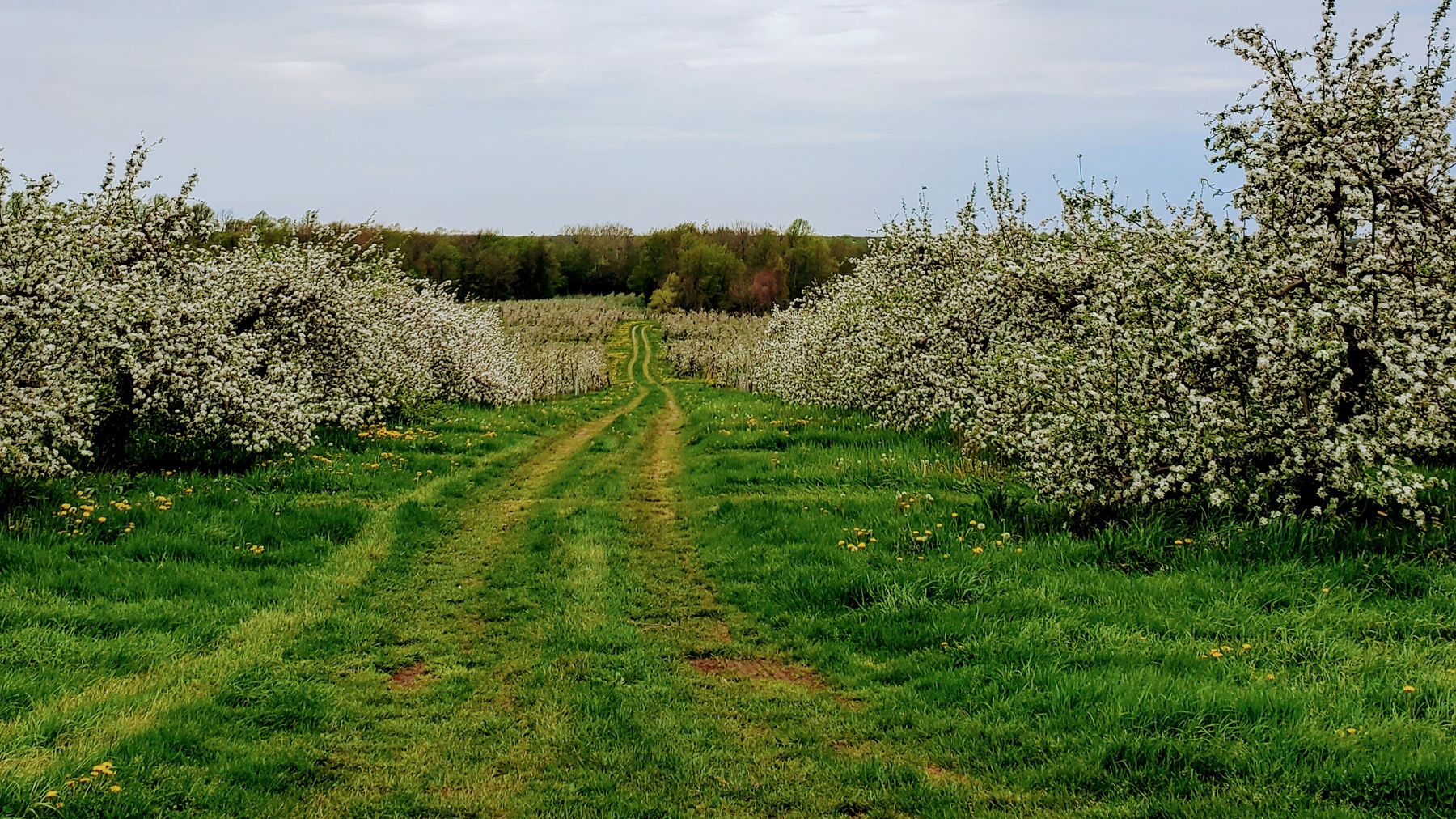Editor’s note: We are continuing our once-a-month series called Field Snapshot to provide a view of what’s happening on farms in the region. Participating farmers are Chip Bowling, a crop producer from southern Maryland; Reid Hoover, a dairy producer from Lebanon County, Pa.; and Teeple Farms, an orchard in Wolcott, N.Y.
Wheat harvest has wrapped on Chip Bowling’s 2,000-acre farm in Newburg, Md. Judging by the yield monitor on his Case IH 7130 combine, yields aren’t spectacular, but they aren’t bad, either — 70-75 bushels an acre with test weights around 60 pounds.
But his corn and soybeans are getting thirsty.
“We haven’t had rain here for two weeks. We’re bone-dry right now,” Bowling says.
His farm endured an intense heat wave last week with temperatures in the high 90s, and on some days, the low 100s, unusual for mid-June. Corn is around waste-high and holding its own, but it curls up in the afternoon heat with a lack of moisture. Soybeans are about 6 inches tall.
“The soybeans aren’t covering the rows yet. The fields look real dry,” Bowling says. “We need rain for sure. Some kind of rain to cool things off. If we don’t get rain, we’ll start seeing the crops go backwards.”
It’s been a roller coaster of a growing season. May saw plenty of rain. Bowling says he was able to get sidedressing done on his corn several weeks ago, the result of ample moisture. But heat and humidity have quickly settled in. It’s gotten so dry so quick, he says, that some of his neighbors are skipping double-crop soybeans after wheat. Not Bowling.
“My rule of thumb is, you get a window to get things done, you go ahead and do it,” he says.
Low commodity prices and high input costs have him concerned. Local basis for corn, soybeans and wheat are all in the red, unusual for this time of year. Wheat basis, which is typically 50 to 75 cents positive this time of year, is negative $1, the worst he has ever seen.
New-crop corn is 25 cents under, and November soybeans are 30 cents under.
Although Brazil has seen torrential rains and parts of the South are baking under intense heat and dry weather, Bowling says he is still waiting for the expected weather bump in prices.
“I’m just waiting with anticipation to see if we’re going to get this weather bump to help with where the prices are,” he says.
If prices don’t turn around, some tough decisions may have to be made this fall. “We planted less wheat this year than we had in a long time,” Bowling says, adding that he may skip wheat altogether if local basis doesn’t turn around.
“I have talked about sitting on the sidelines. Wheat is a nice little boost, but it’s not necessary. I don’t have to plant it. I plant cover crops every year, and so I would probably plant more cover crops. The state of Maryland still has a pretty good cover crop program,” he says.
Cow comfort beats the heat
Crops are growing well on Reid Hoover’s farm outside Lebanon, Pa.
“We got some rye off early and got some corn planted early. And then we started to get some rain. I think it all looks pretty decent,” he says.
Hoover operates Brook Corner Holsteins, a 370-cow dairy with more than 400 heifers and young stock. He farms 650 acres in partnership with his son, Brad; a brother; and a nephew. Cows are milked three times a day. The farm’s rolling herd average is 30,000 pounds, with protein at 3.07% and butterfat near 4.0%.

The farm has 500 acres of corn, a decrease in acreage from past seasons as a field of rented ground that was continuous corn was planted in full-season soybeans, something Hoover says is unusual for them to do.
An in-furrow insecticide to battle corn rootworm was one of the newest things Hoover and his partners tried this spring. “It can really be a problem during chopping as it can weaken the cornstalks, making it harder to chop,” he says.
But dairy is what drives the farm. Last week’s heat wave put the farm’s fans, misters and ventilation systems to the test.
“When we built here, that was our No. 1 goal, was cow comfort and ventilation,” Hoover says. “We like our barn. We have a lot of fans; we have misters going now. Fans are always blowing; misters are on a timer. When it’s real hot outside, it’s pretty nice to be in the barn.”
He still expects dairy production to drop.
“It seems like no matter how good it is, when you have a number of days in a row that are hot, the cows just wear out,” Hoover says. “You really see intakes drop. When intakes drop, then the production drops.”

Nothing is better on a hot summer day than some ice cream. Thankfully, Hoover and his family have plenty at their fingertips. A few years ago, he and his wife, Diane, along with his brother and wife, bought a dilapidated ice cream shop and restaurant a few miles down the road from the farm. After some renovations, they opened Colebrook Crossing, which offers plenty of ice cream specialties and food.
“It’s going good. We just got through Father’s Day. It was kind of crazy,” Hoover says.
“My wife, it’s kind of her thing. She just always thought that place had potential because of the location,” near a rail trail and a busy road.
Still, Hoover spends most weekends at the shop, usually at night helping clean up after closing, even after a long day on the farm.
Apple thinning is complete
The tree thinning is officially done at Teeple Farms in Wolcott, N.Y.
So far, it looks like the harvest will be on target for the farm’s average of 300,000 bushels.
“The fruit is sizing nicely thanks to a successful thin,” said Danielle Teeple, co-owner of the farm with her husband, Frank.

New York’s unexpected cold snap in mid-April worried apple producers because of possible damage to springtime blossoms. But it appears to have had minimal effect on the farm’s 400 acres of apple trees, 100 acres of which are grown organic.
“There are small spots of damage from the cold, but overall, it’s pretty good,” Teeple says, adding that the cold did cause a small amount of scab.
For some organic fruit growers, managing pests can be challenging. Teeple notes that this year, “the organic pest management has been quite easy and light. Our boys love scouting for pests and help us to stay on top of things.”
The farm’s organic apples have shown minimal evidence of codling moth, oriental fruit moth and aphids this season, she says.
Along with the 60-plus H-2A workers the farm employs during the busy times, the Teeples’ sons — Jackson, 16; Philip, 14; and Levi, 11 — help with farm labor. The boys finished their home school year in mid-May and begin a new one this month.
The farm grows 37 varieties of apples, primarily for wholesale, with about 10 bushels a day sold direct to consumers through the farm’s seasonal farm stand.